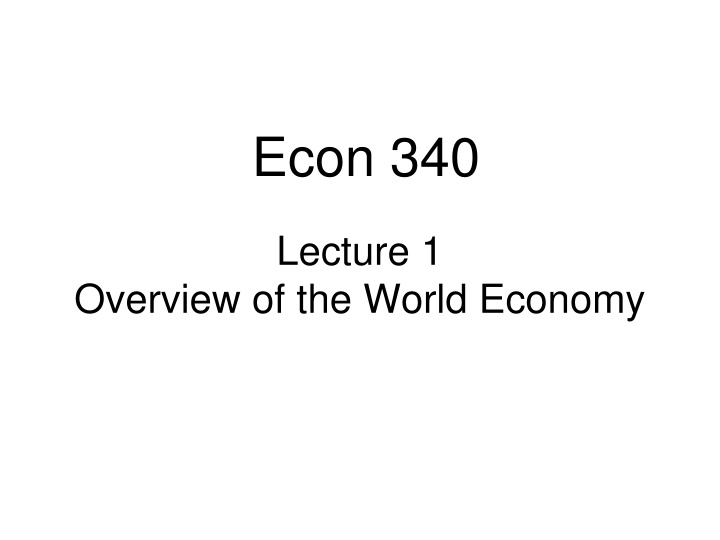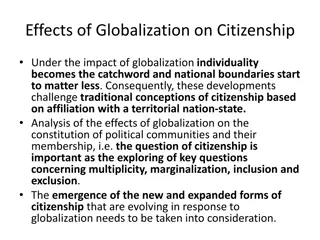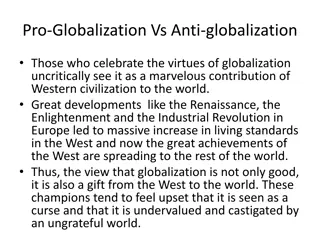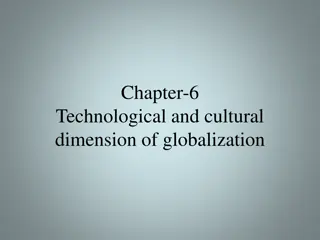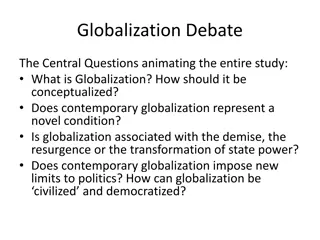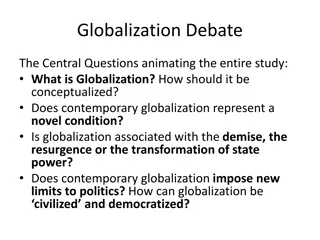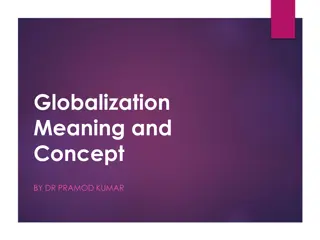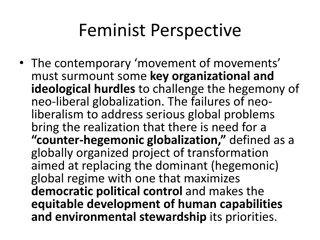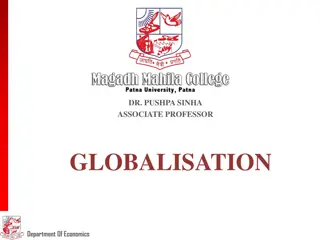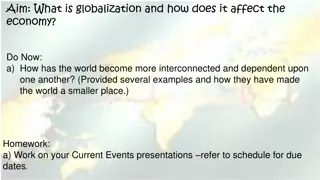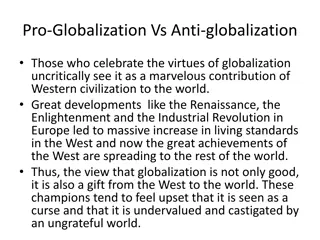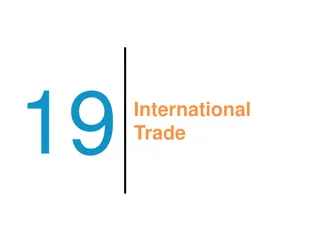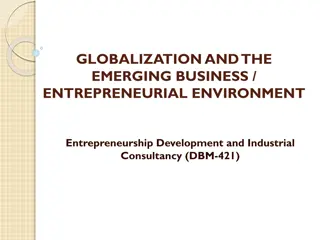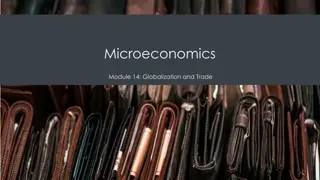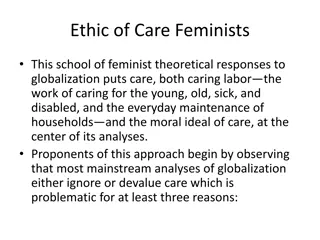Overview of the World Economy: Globalization and Backlash
Various aspects of globalization in the world economy, this overview delves into the interconnected nature of markets, the impact of world events on trade and migration, and the recent backlash against globalization. From changes in global trade patterns to a historical perspective on inequality, this overview highlights the complexities and uncertainties of our interconnected world.
Download Presentation

Please find below an Image/Link to download the presentation.
The content on the website is provided AS IS for your information and personal use only. It may not be sold, licensed, or shared on other websites without obtaining consent from the author.If you encounter any issues during the download, it is possible that the publisher has removed the file from their server.
You are allowed to download the files provided on this website for personal or commercial use, subject to the condition that they are used lawfully. All files are the property of their respective owners.
The content on the website is provided AS IS for your information and personal use only. It may not be sold, licensed, or shared on other websites without obtaining consent from the author.
E N D
Presentation Transcript
Econ 340 Lecture 1 Overview of the World Economy
Announcements We will start discussing news next week, on Monday Sep 16. You should be watching now for international economic news. Be sure to register your clicker on the Canvas site for this course. Lecture 2: Institutions 2
Lecture 1 Outline Overview of the World Economy Globalization Elements of the World Economy Ways that Countries Interact Trade Capital Flows Migration Policies that Affect Others Institutions Lecture 1: Overview 3
Overview of the World Economy Globalization Means different things to different people My definitions (see my online Glossary): 1. The increasing world-wide integration of markets for goods, services and capital. 2. Also the role of MNCs, IMF, WTO, World Bank. 3. Elsewhere: domination by United States. Some see good, others see bad Lecture 1: Overview 4
Overview of the World Economy Globalization Some aspects of globalization, especially trade, Declined with the world recession of 2008, then recovered Slowed down in 2015-16 Resumed growth in 2017 What s next? We don t know! Lecture 1: Overview 5
2015-16 Slowdown World Recession Lecture 1: Overview 6
World Merchandise Exports by Level of Development, 2012Q1 2017Q4 (Volume index, 2012Q1=100) 2015-16 Slowdown Source: WTO Lecture 1: Overview 7
World Merchandise Exports by Level of Development, 2012Q1 2017Q4 (Volume index, 2012Q1=100) Source: WTO Lecture 1: Overview 8
Overview of the World Economy Globalization Backlash There is growing opposition to globalization This happened before, with the First Globalization (See Swanson) Both trade and migration grew strongly up to World War I in 1914 Inequality also grew Trade and migration both declined for decades after Lecture 1: Overview 9
Globalization of Supply Chains Much trade today is intermediate inputs. Supply chains cross national borders multiple times Example from Black Lecture 1: Overview 10
NAFTA and the Auto Supply Chain Black, Diamond, and Merrill, One Tiny Widget s Dizzying Journey Shows Just How Critical Nafta Has Become, Bloomberg, February 2, 2017. 11
NAFTA and the Auto Supply Chain Black, Diamond, and Merrill, One Tiny Widget s Dizzying Journey Shows Just How Critical Nafta Has Become, Bloomberg, February 2, 2017. 12
NAFTA and the Auto Supply Chain Black, Diamond, and Merrill, One Tiny Widget s Dizzying Journey Shows Just How Critical Nafta Has Become, Bloomberg, February 2, 2017. 13
NAFTA and the Auto Supply Chain Black, Diamond, and Merrill, One Tiny Widget s Dizzying Journey Shows Just How Critical Nafta Has Become, Bloomberg, February 2, 2017. 14
NAFTA and the Auto Supply Chain Black, Diamond, and Merrill, One Tiny Widget s Dizzying Journey Shows Just How Critical Nafta Has Become, Bloomberg, February 2, 2017. 15
NAFTA and the Auto Supply Chain Black, Diamond, and Merrill, One Tiny Widget s Dizzying Journey Shows Just How Critical Nafta Has Become, Bloomberg, February 2, 2017. 16
Lecture 1 Outline Overview of the World Economy Globalization Elements of the World Economy Ways that Countries Interact Trade Capital Flows Migration Policies that Affect Others Institutions Lecture 1: Overview 17
Overview of the World Economy International Economics Is NOT about countries It IS about interactions among countries Lecture 1: Overview 18
Overview of the World Economy World Economy consists of Countries: a few hundred (CIA lists about 240) (WTO has 164 members) People: over 7.5 billion (7.504 billion 9/6/19, compare 329 million US) Land: about 15 times the US Lecture 1: Overview 19
(Aside, on getting information) An excellent source of information about countries is the CIA World Fact Book (Just Google factbook ) Lecture 1: Overview 20
Overview of the World Economy World Economy consists of GDP (2017 est., per CIA, in US$) World: Total = per capita = US: Total = per capita = $80.27 trillion $17,500 $19.49 trillion $59,800 Lecture 1: Overview 21
Overview of the World Economy Implication US is very unusual Very rich US has less than 5% of world population but almost 25% of world income (This changes, as measured here in official exchange rates, as the exchange rates change.) Lecture 1: Overview 22
Lecture 1 Outline Overview of the World Economy Globalization Elements of the World Economy Ways that Countries Interact Trade Capital Flows Migration Policies that Affect Others Institutions Lecture 1: Overview 23
Overview of the World Economy Ways that countries interact economically Trade (per CIA, 2017 est.) World exports: $17.31 trillion (compare world GDP of $80 trillion) (That s at official exchange rates) (Exports = 22% of GDP) World trade has grown faster than world GDP most years But not during 2008-9, due to world recession Or during 2015-16 But resumed in 2017 Lecture 1: Overview 24
Trade growth faster than GDP Source: WTO Lecture 1: Overview 25
Overview of the World Economy See tables below for Who trades most? Who trades with whom? Share of trade in GDP US: What do we export/import? To/from whom? Lecture 1: Overview 27
Who Trades the Most? ($ b. & % share, 2018) Exporters Importers Value Share Value Share China US Germany Japan 12.8US 8.5China 8.0Germany 3.8Japan 3.7UK 100.0 World 2487 1664 1561 738 723 19,475 2614 2136 1286 749 674 19,867 13.2 10.8 6.5 3.8 3.4 100.0 Netherlands World Source: WTO, World Trade Statistical Review, 2019, Table A6 Lecture 1: Overview 28
Who Trades the Most? (Excluding intra-EU-28) ($ b. & % share, 2018) Exporters Importers Value Share Value Share China EU-28* US Japan Korea, S. World 16.2US 15.1EU-28* 10.9China 4.8Japan 3.9Hng Kng 100.0 World 2487 2309 1664 738 605 15,319 2614 2337 2136 749 628 15,710 16.6 14.9 13.6 4.8 4.0 100.0 *EU external only Source: WTO, World Trade Statistical Review, 2019, Table A7 Lecture 1: Overview 29
Who Trades the Most? Developed countries are most of the biggest traders China has caught up, in trade volume It was the #3 exporter ten years ago when I taught the course; now it s #1. Others are gaining as well: Six years ago Canada was #5 exporter. Five years ago that was S Korea. Lecture 1: Overview 30
Who Trades the Most? See Economist from five years ago: Trading Up: Picking the world champion of trade China claimed to have surpassed US. True only for goods, not goods + services But with time China will pass US in both China s trade per GDP was much larger than the US, but below world average Much of the value in China s exports is imported inputs, thus low value added. Lecture 1: Overview 31
Who Trades the Most? Emerging Markets in general are catching up to, or surpassing, the developed countries In GDP, trade, and more See Economics Focus from The Economist, Why the Tail Wags the Dog Lecture 1: Overview 32
Who Trades with Whom? ($ b., 2014, Intra- and inter-regional merchandise trade) Destination: North Amer. 1251 173 540 1065 Latin Amer. 214 179 119 185 Eur. Asia Africa Other Origin: North Amer. Latin Amer. Europe Asia Africa Other World 379 114 4665 900 504 170 738 3093 152 828 5485 43 18 97 26 221 207 98 51 639 447 428 20 273 1292 39 29 18 201 532 6792 128 3195 744 Source: WTO, International Trade Statistics, 2015, Table I.4 Note: This source is no longer published, and its replacement lacks these data. Lecture 1: Overview 35
North America, Europe, and Asia trade mostly within their group Poorer regions Latin America, Africa trade mostly with the richer regions This reflects what is not so clear in the table and charts: Rich countries trade most with each other Poor countries trade most with rich countries But their trade with each other is growing Lecture 1: Overview 36
Lecture 1: Overview 37 WTO, World Trade Report 2013
Lecture 1: Overview 38 WTO, World Trade Report 2013
1990 2011 Lecture 1: Overview 39 WTO, World Trade Report 2013
What Does the World Trade? ($ b. 2014 merchandise exports) Value All Products 17,797 Agriculture 1,765 Fuels & Mining 3,789 Manuf. 12,243 Source: WTO, International Trade Statistics, 2015, Table II.1 Note: This source is no longer published, and its replacement lacks these data. Lecture 1: Overview 40
What Does the World Trade? Biggest traded category: manufactures Fastest growing, then shrinking, then growing: fuels & mining Why? Because this is the value of trade, and prices of oil and other raw materials were rising, and then falling. Lecture 1: Overview 41
Did(Not available since 2011) What Does the US Trade? ($ b. 2011) Exports 1,497.4 140.0 Imports 2,235.8 Total Agriculture Petroleum Industrial supplies Capital goods, exc. auto Automotive Other non-ag Other non-petrol 462.3 319.8 513.4 255.2 496.4 493.2 133.1 234.6 685.1 Source: Economic Report of the President, Feb 2013, Table B-104. Lecture 1: Overview 42
What Does the US Trade? US imports are much larger than US exports (We ll see what that means later in the course.) US is a big Exporter of agricultural products Importer of oil (but that s been falling) Exporter and importer of capital goods (i.e., machines for making things) Lecture 1: Overview 43
Trade of US States US states differ substantially in the importance of international trade to them Lecture 1: Overview 44
Importance of Trade for Countries? (GDP in US$ b., Exports % of GDP, Selected countries, 2017) Exports Exports/GDP United States Japan Germany Canada India Mexico Netherlands Singapore Philippines Nepal Source: CIA World Fact Book 1553.0 688.9 1434.0 423.5 304.1 409.8 555.6 396.8 48.2 8% 14% 39% 26% 12% 36% 67% 123% 15% 3% 0.8 Lecture 1: Overview 48
Importance of Trade for Countries? Even though we trade more than most, US trade is a smaller part of US GDP than for many other countries Others that are low: Japan, Nepal (even lower than US) Note Singapore: Exports can be more than GDP. Reason: Exports are made using imported inputs, so value of exports includes imports. Lecture 1: Overview 49
Importance of Trade for Countries? A Few More of Interest GDP Exports/GDP China Hong Kong Korea, South Korea, North (2013) Burma Syria Israel 2216.0 537.8 577.4 18% 158% 37% 11% 15% 7% 17% 3.0 9.8 1.7 58.7 Source: CIA World Fact Book Lecture 1: Overview 50
